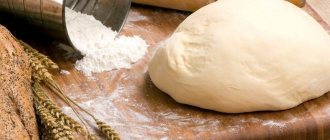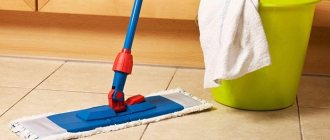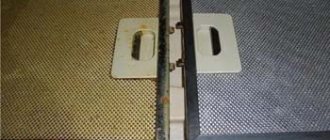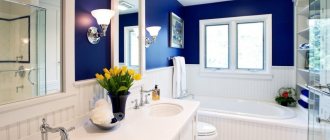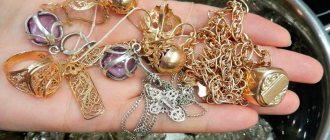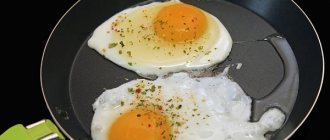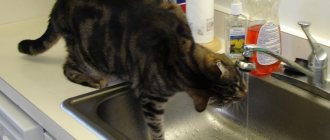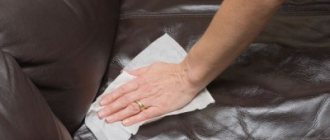Porcelain stoneware is a material with high strength, wear resistance and durability. Even after many years of use, with proper care, it does not change.
There are different types of contaminants, the cleaning of which is carried out in different ways and means.
Cleaning porcelain tiles
In this article, we’ll look at what and how to clean porcelain tiles for various types of contamination.
Why do divorces occur?
In order to carry out quality cleaning, it is important to know the reason for the appearance of certain defects.
The most acute problem is the appearance of stains on the surface even after thorough cleaning. Why does this happen? Let's look at the possible reasons:
- Unwashed dirt. A standard problem is when, when the tile is heavily clogged, dust particles are spread across the surface and it becomes very difficult to completely clean the tiles.
- Dirty water. During cleaning, you need to change the water as often as possible, as it contains dirt particles.
- Hard water. The problem of whitish stains and deposits is mainly associated with the high salt content in tap water.
- Unwashed product. Some cleaning products may remain on the surface of the tiles after washing them. Unless otherwise specified in the instructions, it must be washed clean.
- Dirty rag. In case of heavy contamination, it is recommended to rinse the cloth frequently under running water to remove dust particles.
Types of stains on tiles in the bathroom
Divorces can be of different types. The most common problems are:
- dirty stains;
- limescale;
- traces of detergents;
- greasy stains.
To cope with these problems, you need to select acidic media. They perfectly destroy dirt and at the same time give the tiles a glossy shine.
How to clean porcelain tiles
Cleaning porcelain tiles depends on the degree of contamination.
If during the repair work the dirt was removed from the tiles immediately, then upon completion of the repair it will be enough to wash the tiles to remove any resulting dust. To do this you need:
- Clean the surface from large fractions of debris and other contaminants.
- The remaining dust on porcelain tiles is cleaned with a damp cloth soaked in any soap solution.
- To prevent streaks, the fabric used must be rinsed well in water.
- After cleaning the floor, it is recommended to rub the tiles with a dry cloth.
Important! Window sprays containing alcohol will help avoid streaks on polished tiles.
Cleaning joints between tiles
The tile seams are the most vulnerable spot on a tiled wall. They quickly lose color because... Dirt most often accumulates in them and mold develops. They are also unstable to some cleaning agents. For example, under the influence of hard tools and acidic detergents, the grout mixture may collapse.
The following are considered safe for cleaning seams:
- Steam cleaner. A powerful jet of steam will not only clean any type of dirt, but also get rid of fungal infections. No additional chemicals are required.
- Toothbrush. It is convenient and safe to apply cleaning compounds.
- Gel and liquid bleaches and antiseptics.
If the seams cannot be cleaned or the area of clearance is large, then the easiest way is to replace the grout. To do this, you need to arm yourself with a thin, sharp tool (such as a scraper) to clean out the damaged grout, a new mixture (preferably epoxy) and a rubber spatula. During work, the seams must be soaked with an antiseptic.
Bleaching the seams
Seams that have darkened but remain intact and not affected by mold can be bleached. For work, use household chemicals or improvised products. The most common of them:
- Marker. It is simple to use, but the effect of such an update is short-lived.
- Ready-to-use composition with a whitening component - German Mellerud, Canadian Grout. Both products are designed for cleaning grout, have properties that restore the color of grout, and remove mold and stains.
- A mixture of hydrogen peroxide and baking soda. A paste of these ingredients is rubbed into the seams with a toothbrush and left for 1-2 hours. Then the seams are thoroughly wiped.
Construction dust
The most harmless type of pollution, perhaps, is construction dust; its presence is inevitable when carrying out any repairs, both major and light cosmetic. After repairs, the tiles have to be washed to remove the accumulated layer of dust particles. At the same time, the question becomes relevant - how to wash the tiles and remove dirty stains without damaging its coating.
To begin with, it is recommended to sweep away the dirt with a dry cloth, and if possible, vacuum the surface. This will remove the main layer of dust and large particles that could damage the glaze. If possible, carefully scrape off any hardened finishing materials with a blade. Only after this will it be possible to begin wet cleaning to completely clean the tiled surface.
You can clean the tiles using the following means:
- Soapy water. The simplest, but very effective way. You can use washing powder.
- Water with lemon. Gives shine to a glossy surface and has a pleasant aroma.
- Vinegar. Also diluted in water. Suitable for cleaning serious stains, it also makes the surface shiny and creates a protective film.
- Glass cleaner. A simple, convenient and effective product that allows you to wash away dirt and remove stains from the surface.
Basic products for cleaning tiles from construction dust
Rules of care
Cleaning begins with dry collection of waste. To do this, you can use a vacuum cleaner, brush or broom. Particular attention should be paid to the seams. They get filled with dust.
Then you should wipe the stains. If necessary, you can use special detergents for this. And only after that wash the entire surface.
The last stage is adding shine. Of course, this does not apply to matte floor coverings. You can use household chemicals and folk remedies for this.
Advice!
After washing, wait until the floor is dry and look at it from different angles. If there are any flaws, it is better to remove them immediately rather than wait until next time.
Pollution prevention
To some extent, avoiding the unpleasant consequences of repairs in the form of the need to clean the tiles from grout and tile adhesive residues on the floor of the bathroom or kitchen, from traces of primer, paint or whitewash when finishing walls and ceilings, will help with basic steps:
- When carrying out work involving the use of wallpaper paste, primers or various types of paints, the surface of the floor or walls lined with ceramic tiles must be covered with plastic film, paper, cardboard or any other suitable material available. Otherwise, stains from these substances can add a lot of work to your work during the final cleaning of the tiles.
- When installing porcelain tiles or tiles, any remaining adhesive mixture must be immediately removed from their surface with a damp rag or sponge. Cleaning dried adhesive, especially from embossed ceramic tiles, is a labor-intensive task and, in some cases, costly, requiring the use of expensive products.
- Difficult to remove stains can also remain from traces of grout that were not removed from the tile in time. That is, the remaining grout is removed as the work on processing the seams with a fugue is completed.
Classifications of porcelain stoneware based on anti-slip properties
There are 2 anti-slip indicators:
Coefficient R - resistance to slipping when walking in shoes in places where substances such as fats, oils, water, food residues, powders, flour, vegetable waste often fall on the floor. The groups are classified from R9 to R13.
| R9 | The tiles are intended for finishing inside dry rooms . Optimal for residential, educational and public premises, changing rooms. |
| R10 | Tiles for public areas and premises with a risk of water ingress ( periodic wet cleaning ), cafes and restaurants, public toilets, locker rooms at swimming pools and sports centers. Those. for those places where there may be moisture, but only briefly, as after cleaning. |
| R11 | The tiles are intended for public areas and premises with a likelihood of water accumulation (steps and platforms in street areas with high traffic volumes, near buildings with social operational responsibility). |
| R12 | The tiles are intended for industrial use : for rooms with negative temperatures (for example, refrigerators), fire department buildings, wastewater treatment and recycling plants. |
| R13 | Maximum anti-slip coefficient. These are tiles for special needs for covering outdoor surfaces. |
Coefficient A, B, C
– these indicators are used when deciding on the finishing of rooms in which the floor is often wet and people walk on it with bare feet. The classification is used according to the principle: A; B (A+B); C (A+B+C).
| A | Changing rooms, areas for barefoot people, etc. |
| IN | Shower rooms, pool sides, etc. |
| WITH | Sloping pool sides, underwater stairs, etc. |
Types of pollution
In order to choose a way to fix the problem, we need to figure out what we have to deal with. During renovations, many different liquids, mixtures and other chemicals are used that can literally leave a mark on your apartment for many years.
It is worth noting that such consequences are much easier to prevent in advance. This is not so difficult to do: just cover the surface with a special protective film. If you ignored this action for some reason, you simply cannot do without cleaning. Most often, in the process of finishing work, the following fall on the tiles:
- lime;
- plaster;
- grout mixture;
- silicone sealant;
- primer;
Cleaning tiles in the bathroom after renovation
- adhesive solution;
- polyurethane foam;
- dye;
- construction dust.
Naturally, they all cause damage to varying degrees, so each of them should be considered separately.
Household chemicals for cleaning tiles
Here it is also worth considering the type of surface being treated, because glossy surfaces are much easier to clean than matte and porous ones.
Cleaning the tiles
Any action must begin with preparation. In our case, this is the choice of detergent - first of all, decide what you will use for yourself - a folk method or a specially developed solution, powder or gel.
The tiles must be wiped dry
Folk remedies
Despite the fact that progress has gone far ahead, many remain faithful to the good old “grandmother’s” methods. And this is not without reason. The price of these products is simply symbolic, they have been proven for decades, and the effectiveness is not inferior to the most famous advertised products. And these products are always at hand - you don’t need to go to the supermarket, choose, or spend money for them.
First, remove large debris
We have collected all the most effective ones in a table, “seasoning” them with the wonderful properties of these substances.
| Microfiber cloth + dishwashing liquid | The first element gently collects stubborn dirt, and the second element destroys the structure of fat and other dirt. |
| Bleaching powder | An ideal product for white tiles and the answer to the question “How to clean bathroom tiles?” And a plus - excellent disinfection. |
| Chalk + paper | A successful combination for cleaning glossy tiles. Chalk fights dirt, and treatment with paper after it dries gives the tiles a pristine shine. |
| Citric acid (lemon juice) | In the literal sense of the word, it corrodes grease and other dirt - it is needed by those looking for something to clean the tiles in the kitchen. |
| Vinegar | Cleaning and disinfection – two in one. |
| Ammonia | Ammonia has an unpleasant odor, but it is very effective at removing dirt and restoring shine to surfaces. |
All products are used very simply - diluted in water, after which the surface is treated with the solution.
The soap solution must be rinsed off with clean water.
Special equipment
But in some cases it is still better to give preference to special means. Let's list the most powerful and proven ones, which make it very easy to wash tiles.
“Silit” is one of the most effective remedies, the results of which are visible within a few minutes. Suitable for both wall, ceiling and floor tiles. The remedy from Amway has no claims about its effectiveness. But what makes it stand out is its high price.
Many housewives also pay attention to the active gel from this company - it can be added to other products to further activate their action. “Selena” And this remedy, on the contrary, is one of the most economical. It removes stains and grease stains perfectly. “Mr. Proper” Both a universal product and products from a special line for tiles will help. Melamine sponge Miracle sponge, which you saw in the photo, already contains an active substance - so you just need to wet it and then treat the surface with it
Many note that it is excellent at fighting stubborn fat deposits. “Mr. Muscle” A non-trivial method - but this glass cleaner will remove stains from tiles and give it shine with the same effect.
Please also pay attention to a number of products containing chlorine. This component perfectly fights traces of rust, limescale, and also disinfects tiles.
Now let's move on to the process itself.
Correct algorithm
To ensure that the tiles are in perfect condition by the end of cleaning, we advise you to follow this order in your actions:
- Use a rag, brush, or mop to remove all large debris from the surface.
- Use a dry cloth or rag to thoroughly wipe off the dust.
- Dilute one of the selected products in a bucket and treat the surface with a sponge, rag, or brush soaked in it. Physical effort may be required for cleaning to be effective.
- Rinse the tiles from the foam “coating” with clean water.
- If contaminants remain, it’s time to use a more serious remedy against them. For convenience, it can be sprayed with a spray bottle.
- Rinse the tiles clean with water again.
- Finally, use a surface shine product. It can be replaced by rubbing with paper or dry cloth.
The video in this article will clearly demonstrate these actions.
How to clean glossy porcelain tiles
Porcelain stoneware is a material with high strength, wear resistance and durability. Even after many years of use, with proper care, it does not change.
There are different types of contaminants, the cleaning of which is carried out in different ways and means.
Cleaning porcelain tiles
In this article, we’ll look at what and how to clean porcelain tiles for various types of contamination.
Methods for cleaning ceramics from various contaminants
We will present for review an effective method for cleaning tiles from the most common types of contaminants, using both special products and cleaning methods with improvised materials and substances.
Due to the fact that the cladding of the bathroom walls occurs after the installation of ceramics on the floor, there is a danger that the primer compositions used to prepare the wall surface for finishing will come into contact with fragments of the floor covering. Wipe off stains from dried primer is a serious test of endurance and patience, so you should not allow it to get on the ceramic surface, and if this happens, then you need to remove the spills immediately using ordinary water.
Since tile is a material that is resistant to various types of adverse effects, many products are suitable for washing it
The following methods are used to clean dried primer:
- stains are dissolved with a special remover;
- the primer is washed off with acetone;
- the contamination is treated with a liquid primer;
- use of vinegar essence.
To make the dried primer easier to remove, the contaminated areas are covered with a wet rag, and some time is given to soften the dried stains.
Particularly difficult areas can be cleaned mechanically, namely using a special scraper. It is a device consisting of a handle and interchangeable blades. Pre-soaked stains are carefully removed with a scraper so as not to damage the tile; the tool must be held at an angle of 30 degrees to the surface of the tile.
Cement mortar that has not set is easily washed off with a wet sponge or rag and clean water. But you will have to tinker with the frozen solution:
- Cleaning with special removers.
- Toilet bowl cleaner works well on dried cement mortar.
- Mechanical cleaning method. Traces of the solution are removed with a metal spatula or a metal mesh for washing dishes.
We remind you that when using the mechanical method, the dried solution must first be soaked and when cleaning with metal objects, do not damage the surface of the finishing material.
After repairs, the cement should be removed from the tiles immediately before it has time to harden.
Tile adhesive
- Traditionally, the easiest way to promptly remove glue residues during the installation process is with a wet sponge.
- The frozen glue is soaked in a solution of water and vinegar or ammonia.
- Chemical treatment of contaminated areas with potent substances.
- Mechanical cleaning. Traces of glue are removed using a metal spatula, scraper, metal mesh or fine sandpaper.
Key moment. In “hopeless” cases of strongly set glue stains, it is advisable to use chemical and mechanical methods in combination.
To facilitate the process of cleaning grout from the surface of tiles in the bathroom, you must strictly follow the technology of finishing joints with fugue, do not apply too much grout to the surface to be treated and remove its excess in a timely manner.
First of all, we need to remove traces of glue as soon as possible, especially if we are dealing with ceramic tiles
There are two removal methods:
- Chemical. The method is based on the use of potent, acid-containing substances. Using this method, you need to take into account the properties of the ceramic used and its resistance to acids. We should not forget about safety measures when working with active substances, be sure to use personal protective equipment.
- Mechanical. The method is used to clean heavily dried grout or grout that is resistant to chemicals. The following tools and devices are used:
- metal spatula, brush or scraper;
- various cutting devices with a sharp blade;
- sandpaper or metal abrasive mesh.
Construction dust
The most common and “obligatory” type of pollution after construction and repair work is the presence of construction dust. Removing it is a simple process and does not require the use of any special or potent substances.
It is necessary to remove dust as soon as possible so that dust and dirt do not become embedded.
First, dust is removed from the surface with a dry cloth or using a vacuum cleaner, after which wet processing of the cladding begins, for which the following means are used:
- warm soapy water;
- water with lemon or citric acid added;
- vinegar solution;
- compositions for cleaning glass.
Ceramic tiles should be washed from top to bottom.
Means for protection
Builders and porcelain tile manufacturers recommend using special products that contain natural and synthetic waxes to protect floor tiles. These products are applied with a soft spatula and rubbed over the entire surface of the slabs. Their use makes it possible to clean using ordinary water.
Protective agents can also include products that prevent stains from forming on porcelain tiles. These are products such as IMPRETOP (resin-based) and Moeller HMK S33 (silicone-based). They are applied undiluted exclusively to a clean and dry floor using a soft cloth, according to the principle of applying mastic. If necessary, remove excess product and wipe the floor with a dry soft cloth. You should then leave the floor for 24 hours to allow the product to dry completely.
After renovation
How to clean tiles after renovation?
Eliminating the consequences of repairs is somewhat more difficult - especially in cases where the tile structure is porous and rough. “Harmless” construction dust is collected with a vacuum cleaner, otherwise the following approaches are used:
- It is necessary to wash off the glue “without delay”. A vinegar solution (a quarter cup per 1 liter of water) will do a wonderful job with this task; it will also rid the tiles of lime and putty. The brush should be quite stiff, but in no case metal - otherwise scratches will definitely be inevitable. Repeat rinsing several times, then dry the tiles with a soft cloth.
- The hardened liquid nails are carefully separated with a scraper (to facilitate the process, the glue is blotted several times with warm water or acetone). You can do something completely different: heat the stained area with a hair dryer and remove the solution as it melts (by the way, the same approach will eliminate frozen silicone). Due to their structure, liquid nails can withstand temperatures from -5 to +50 degrees, so instead of heating, you can successfully freeze them - the glue will crack and begin to crumble.
- Sticky traces of adhesive tape instantly disappear under the onslaught of acetone or a solvent like White Spirit.
- To wipe off fresh primer, use soapy water. Dried drops can be re-soaked with the same primer and immediately wiped dry. Of course, you shouldn’t rush with this extravagant method - first try using solvent, gasoline, glass cleaner or a special paint remover. In some cases, polishing with soda paste or vinegar essence is effective.
- If putty gets on the tile, it must be soaked with warm water and carefully scraped off with a plastic spatula. Wash the tiles with water and detergent, rinse and dry.
- Dried grout should be scraped off with a piece of wool or felt cloth. Then the tiles are washed using the same technology as in the previous case.
Tip: moisture-resistant grout mixtures can be used for minor cosmetic repairs: they perfectly mask chips and cracks on the tiles.
Of course, it’s better not to hesitate with cement-sand mortar: absorb dirt with a wet sponge as it appears. If the solution has managed to harden, you will have to do some work: first soften it with cold water (you can drop a little lemon juice), then crumble it and collect the dust with a damp cloth. Table salt also helps to remove cement from the surface of ceramics. Sprinkle the floor with dry grains, then moisten with water and leave for a few minutes. When the consistency becomes loose, remove the residue with a soft spatula or brush. Many toilet products can remove old solution. You need to soak the stains for two or even three days, periodically apply a fresh layer of the composition
Finally, wipe the tiles with a clean, damp sponge. If handled carelessly, grouts and silicone sealants can become a real headache. After drying, the substances included in their composition literally stick tightly to the tile, so soaking will also be required here
Plain water most likely will not have the desired effect; glass cleaner, pure vinegar essence, or any alcohol will do instead. Another way to remove Ceresite-type puffer is to treat the stains with diluted kerosene or a saturated solution of citric acid (half a glass of powder per 2 glasses of water). It is possible that the anti-scale agent in teapots will work.
Paint stains should be treated as soon as possible with gasoline or solvent. To wash off the composition, first use soap and then clean water. Facing damaged by liquid glass can be repaired with a weak solution of vinegar or just hot water. The stain is soaked for forty minutes (fix a wet cloth on the tile), and then cleaned off with a toothbrush. Washing off - alternately with soap and clean water - will be followed by treatment with a glass cleaner.
Tip: special paint for bathrooms helps give a “second youth” to worn-out cladding. First, the tiles are sanded and degreased with acetone (try the procedure on one inconspicuous tile); after drying, varnish is applied in two layers. If desired, you can limit yourself to a simple pattern applied with epoxy paint using a stencil.
Grandma's advice
Grandmothers, like many of us, are fierce opponents of household chemicals. Therefore, in order to wash the tiles from grout or other stains after renovation, even in their youth they used a common ingredient that can be found in any housewife’s cabinet - citric acid.
Remember, when you leave the product on for a few minutes, be careful not to let it dry completely. Otherwise, the process will need to be repeated.
This way, you can not only achieve a perfectly clean surface without leaving a trace of grout, but also refresh your bathroom or kitchen with the smell of fresh lemon!
Primer
Now let's look at how you can clean ceramic tiles from primer after repair. White stains often remain on floor tiles, since the installation of wall cladding is carried out after it has been laid. It is advisable to spread a protective film on the floor, but this does not always provide a 100% guarantee of protection against stains.
If the primer gets on the tile, it is advisable to wash it off with clean water as quickly as possible. When the substance dries it will harden and it will be much more difficult to wash it off. For this purpose, you can use the following tools:
- special solvent-based remover;
- acetone;
- polyurethane foam;
- fresh primer.
As soon as the stain softens, you can try to clean it off. You can also use a special scraper with a sharp blade, which can be used to remove drops of frozen paint from glass surfaces.
The primer is best washed off before it hardens with clean water or solvent
How to clean fat
Vinegar and baking soda will help thoroughly clean floor tiles from grease accumulations. If the latter are mixed and then applied to a heavily contaminated surface, then after a quarter of an hour all the dirt will dissolve. You just need to clean it with a damp cloth.
In addition, you can get rid of grease on tiles with the help of lemon. It easily removes stubborn stains from many food items. The dirt should be wiped with a lemon slice or treated with juice. Subsequently, even stubborn dirt will dissolve.

